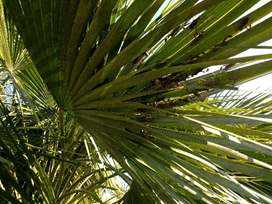
Winter temperatures this 2016 / 2017 season were not cold enough to have any negative impact on overwintering populations of leaffooted bug. Since mid-October we have monitored large populations on a ½ mile-long pomegranate hedgerow in the Parlier area. Aggregations averaged about 206 individuals on 19 October with just over 50% of the individuals at the 4th and 5th instar stage. Temperatures remained mild through November and by the month’s end aggregation size averaged ~30 individuals with 16 and 66% of the bugs at the 5th and adult stage respectively. The decrease in aggregation size likely occurred due to new adults leaving and not adult or nymph mortality. The temperature did reach a low of 27° F during the early morning hours of 20 December yet no adult or nymph mortality occurred.
Our data suggest that female leaffooted bug began laying eggs on the pomegranate during early September and an entire generation was produced by the end of November. As the temperatures cooled and the pomegranates began losing leaves and the fruit rotted and dropped, essentially all the adults left for more sheltered overwintering sites. In this case, several thousand of those individuals moved to a nearby palm tree and large Cyprus trees.
We have closely monitored the aggregations on the Cyprus trees since mid-February and until early-March the aggregations have remained compact consisting of roughly 5 to 40 adults. Temperatures have now warmed and we are seeing smaller aggregations, greater flight activity, and individuals on nearby citrus trees. I interpret this increase in leaffooted bug activity as an indicator that the bugs have begun to disperse and will soon move into almond in search of food.
Weekly monitoring should begin within the next seven to 10 days through May, and then every one to two weeks through June. In the past, I have recommended positioning yourself so that the sun is behind you and using a long pole to knock branches in the upper tree canopy. This causes leaffooted bugs to fly such that they can be seen or heard. However, a simpler method is to forego the long pole and visually search the sunny side of tree canopies for about 15 – 20 seconds each. Importantly, at this early stage in the season, focus on orchard edges near pomegranate and common overwintering sites such as palm and Cyprus trees.
Note that visual monitoring should include inspection for gummosis on almond hulls as the season progresses. Be aware, however, that damage is/has already occurred if gummosis is found. When inspecting nuts with gummosis, cross-section the area to determine the presence of a pin-sized discolored wound caused by the penetration of the insect’s mouthparts. This is important since gummosis also occurs due to physiological damage. Leaffooted bug feeding induced gummosis appears clear to light amber color while bacterial spot induces dark amber to orange gummosis. Additionally, inspect fruit on the ground for the presence of gummosis and a stinging wound to determine if leaffooted bug caused the damage.
Unfortunately, no treatment threshold exists. If damage or leaffooted bug are found, consult the University of California Pest Management Guidelines for management options.
Insecticide use should occur only if monitoring indicates the presence of leaffooted bug and/or its feeding damage. Apply insecticides only after considering the potential risks of the compound to beneficial organisms, including bees and biological control agents, and to air or water quality. For more information on these topics please consult the UC IPM Pest Management Guidelines for Almonds.

